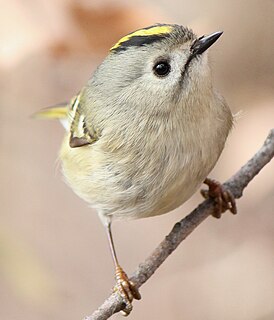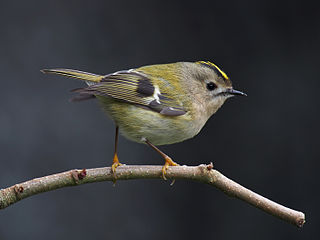
The Pallas's leaf warbler or Pallas's warbler is a bird that breeds in mountain forests from southern Siberia east to northern Mongolia and northeast China. It is named for German zoologist Peter Simon Pallas, who first formally described it. This leaf warbler is strongly migratory, wintering mainly in south China and adjacent areas of southeast Asia, although in recent decades increasing numbers have been found in Europe in autumn.
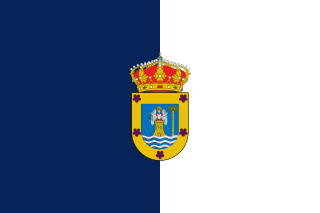
La Palma, also San Miguel de La Palma, is the most north-westerly island of the Canary Islands, Spain. La Palma has an area of 706 km2 making it the fifth largest of the seven main Canary Islands. The total population is about 81,863, of which 18,000 live in the capital, Santa Cruz de la Palma and about 20,000 in Los Llanos de Aridane. La Palma has "sister city" status with El Dorado Hills, California. Its highest mountain is the Roque de los Muchachos, at 2,426 metres, being second among the peaks of the Canaries only to the peaks of the Teide massif on Tenerife.
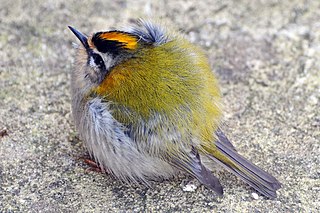
The common firecrest also known as the firecrest, is a very small passerine bird in the kinglet family. It breeds in most of temperate Europe and northwestern Africa, and is partially migratory, with birds from central Europe wintering to the south and west of their breeding range. Firecrests in the Balearic Islands and north Africa are widely recognised as a separate subspecies, but the population on Madeira, previously also treated as a subspecies, is now treated as a distinct species, the Madeira firecrest, Regulus madeirensis. A fossil ancestor of the firecrest has been identified from a single wing bone.
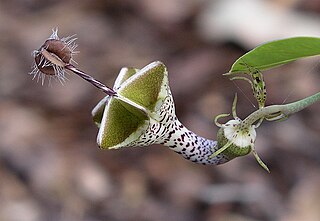
Ceropegia is a genus of plants within the family Apocynaceae, native to Africa, southern Asia, and Australia. It was named by Carl Linnaeus, who first described this genus in volume 1 of his Species plantarum, which appeared in 1753. Linnaeus thought that the flowers looked like a fountain of wax. From this the scientific name was derived: ‘keros’ meaning wax and ‘pege’ meaning fountain. They have many common names including lantern flower, parasol flower, parachute flower, bushman’s pipe, string of hearts, snake creeper, wine-glass vine, rosary vine, and necklace vine.

Arbutus is a genus of 12 accepted species of flowering plants in the family Ericaceae, native to warm temperate regions of the Mediterranean, western Europe, the Canary Islands and North America. The name Arbutus was taken from Latin, where it referred to Arbutus unedo.

The Tenerife goldcrest, Regulus regulus teneriffae, is a very small passerine bird in the kinglet family, closely resembling the goldcrest but with a broader black band across the forehead, slightly darker underparts and a longer bill. It breeds in the Canary Islands of Tenerife and La Gomera, where it is a non-migratory resident. It prefers Canary Island Pine forests, but also occurs in laurisilva forests.

The flamecrest or Taiwan firecrest, is a species of bird in the kinglet family, Regulidae, that is endemic to the mountains of the island of Taiwan.

The Madeira firecrest, Madeira kinglet, or Madeiracrest is a very small passerine bird endemic to the island of Madeira. It is a member of the kinglet family. Before it was recognised as a separate species in 2003, it was classified as a subspecies of the common firecrest. It differs in appearance and vocalisations from its relative, and genetic analysis has confirmed it as a different species. The Madeiran bird has green upperparts, whitish underparts and two white wingbars, and a distinctive head pattern with a black eye stripe, short white supercilium, and a crest that is mainly orange in the male and yellow in the female.
Canary Islands Goldcrest may refer to:
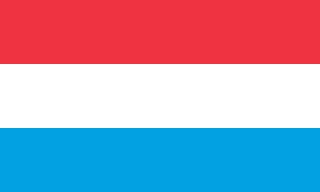
There are a number of national symbols of Luxembourg, representing Luxembourg or its people in either official or unofficial capacities.
The southern forest bat is a vespertilionid bat found in Australia.
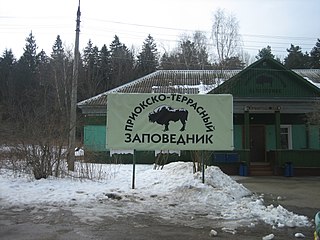
Prioksko-Terrasny Nature Biosphere Reserve is one of Russia's smallest zapovedniks, sprawling over an area of 5,000 hectares along the left bank of the Oka River in the Serpukhov District of Moskva Oblast. It was established in 1945 as part of the Moscow Nature Reserve and is home to 900 plant species, 130 bird species, and 54 mammal species. A wisent nursery was established in 1948 to populate the region with European bisons from the Belovezhskaya Pushcha and Western Caucasus. There is also a small herd of American bisons.
The Santa Maria goldcrest, Regulus regulus sanctaemariae, Estrelinha-de-poupa in Portuguese, is a very small passerine bird in the kinglet family. It is endemic to Santa Maria Island in the Azores archipelago in the North Atlantic Ocean where it is a non-migratory resident.
The São Miguel goldcrest, Estrelinha-de-poupa in Portuguese, is a very small passerine bird in the kinglet family. One of several goldcrest insular subspecies in the North Atlantic archipelagos of Macaronesia, it is endemic to São Miguel in the Azores where it is a non-migratory resident.
The Western Azores goldcrest, Estrelinha-de-poupa in Portuguese, is a very small passerine bird in the kinglet family. It is endemic to the Azores archipelago, in the North Atlantic Ocean, where it is a non-migratory resident of the islands of Flores, Faial, Terceira, São Jorge and Pico.
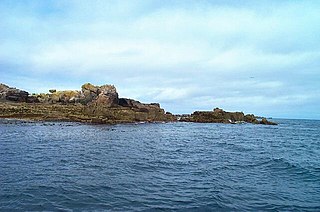
Rosevear is the largest of the group of rocks known as the Western Rocks, Isles of Scilly. The islands are on eastern side of the Atlantic Ocean on the south-west approaches to the island of Great Britain and are renowned for the numerous shipwrecks in the area and the nearby Bishop Rock lighthouse. All the uninhabited islands are owned by the Duchy of Cornwall and are managed by the Isles of Scilly Wildlife Trust, which looks after the archaeological and historical remains on the islands, as well as the flora and fauna. Landing is not allowed on the island.

